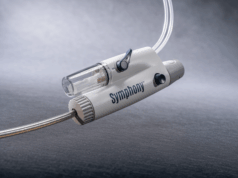
We need to find other physician groups to support neuroradiologists in the delivery of mechanical thromebectomy. But are interventional radiologists, as those who regularly perform procedures with similar technologies to those used for mechanical thrombectomy, the right group to support this initiative? Trevor Cleveland, Sheffield, UK, details some of the challenges.
Stroke is a major cause of death and disability, for which the UK Department of Health formulated a strategy in 2007. A significant part of that strategy was the acute treatment of stroke, recognising that “time is brain”, and gave recommendations for the use of thrombolytic agents. The National Clinical Guidelines for stroke on 2012, published by the Royal College of Physicians, emphasised the importance of early treatment with the benefits of starting treatment after 4.5 hours being unproven. The intention of thrombolysis is to re-establish blood flow to the brain, before there has been irreversible ischaemic damage. More recently, a series of randomised trials have been published which show that there is an additional benefit of mechanical thrombectomy in patients with large artery occlusion strokes.
The question now facing many healthcare systems around the world is how best to implement a service maximising the use of such techniques?
In common with many other situations, the translation of trial results into everyday clinical practice is not an easy one. Randomised clinical trials are performed in very defined and controlled circumstances. The trials investigating mechanical thrombectomy were done with specific case selection and procedures performed by teams of experienced neurointerventionalists. Replicating identification of relevant patient groups is relatively easy; it is however, much more problematic to get patients to a place where intervention can be undertaken, and to deliver the procedures in a timely fashion.
In the UK, patients can present to any acute hospital, be considered for thrombolysis, and transferred to the nearest Hyper Acute Stroke Unit (HASU). However, few of these units have a 24-hour interventional neuroradiology service.
To deliver mechanical thrombectomy in a robust fashion will require teams (including doctors able to make the diagnostic decisions and deliver the mechanical thrombectomy, radiographers, nurses, anaesthetic support, postoperative care, etc). These teams will need to be rapidly available both in, and out, of hours. It will also crucially need patients to be transferred to the places where such services are available. It would seem unlikely that a patient could be transferred into a HASU and then a further transfer to a centre with mechanical thrombectomy availability, within the time constraints. Therefore, such services will need to be available in sufficient numbers and locations to allow a consistent level of care across the population, with primary transfer to those centres.
At the moment, in the UK, there are very few centres able to deliver a 24/7 neurointerventional service. The options therefore would seem to be to either try to rapidly train a cohort of interventional neuroradiologists, or to identify a group who have sufficient transferrable skills, who can relatively quickly gain experience in mechanical thrombectomy, sufficient to provide a service with outcomes that deliver benefit to patients.
Training a large enough cohort of neuroradiologists would take a number of years, and would also require a considerable financial commitment to support such a scheme. In the present climate it seems difficult to believe that this would be forthcoming, particularly in the timeframe necessary to deliver a service within the next few years.
That means, we need to find others to support neuroradiologists. Are interventional radiologists the right group to support this initiative?
Interventional radiologists regularly perform procedures with similar technologies to those used for mechanical thrombectomy. They perform super selective catheterisation of many arteries (although notably, rarely the cerebral circulation) and use coaxial systems and microcatheters for a variety of elective and emergency procedures. As trained radiologists they also have the background skills that would translate into the interpretation of the imaging that underpins the selection of patients who may benefit from mechanical thrombectomy.
Thus it would seem that interventional radiologists are probably the group most suited to support neuroradiology in the delivery of mechanical thrombectomy.
However, this is not without practical difficulties. Many interventional radiology acute services are under pressure with an estimated shortfall of around 200 interventional radiologists in the UK. The concept of additional emergency workload is one that may not meet with enthusiasm or financial support (a funding stream to support mechanical thrombectomy for both neuroradiologists and interventional radiology seems unclear at present). Further, interventional radiologists will need to be given sufficient time and support to enhance their neuroradiology diagnostic skills, to refamiliarise themselves with the cerebral circulation, and learn the use of the mechanical thrombectomy devices. A mentoring process would seem to be suited to this. Even in such circumstances, it is uncertain if sufficient numbers of interventional radiologists (in suitable locations) would be willing to take on mechanical thrombectomy. This would also need appropriate governance arrangements to allow for their experience/training to be monitored, and to ensure that their outcomes would be sufficiently reliable to deliver the benefits shown in the mechanical thrombectomy trials.
There seems little doubt that mechanical thrombectomy has the potential to offer patients with stroke a significant improvement in prognosis. The practicalities of how best to achieve this remains unclear, but interventional radiologists have the potential to offer significant expertise. This will need efficient patient pathways, alongside a well-supported national strategy.
Trevor Cleveland is a consultant vascular radiologist, Sheffield Vascular Institute, Sheffield Teaching Hospitals, Sheffield, UK. He has reported no disclosures pertaining to this article










